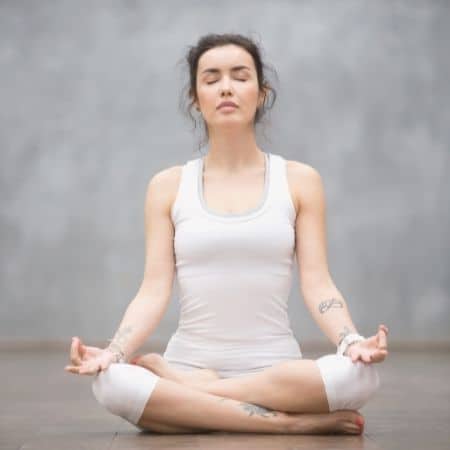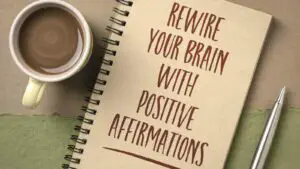Mindfulness meditation involves turning inward by focusing on your breath, slowing down your thoughts, and connecting deeply with your mind and body. Proper breathing is the key to entering a deeper meditative state, and while it seems self-evident, ‘proper’ breathing isn’t that straightforward.
To properly breathe during mindfulness meditation, you should tailor your breath to the type of mindfulness meditation you’re practicing. For the most part, this kind of breathing involves allowing the breath to enter and leave the body naturally without consciously altering its flow in any way.
In this article, I’ll explore the different kinds of mindfulness meditation and tell you how to breathe during each one.
Mindfulness Meditation: The Different Types
The goal of mindfulness meditation is to observe your state of being without judgment and allow yourself to simply ‘exist’ as you focus on the breath flowing in and out of your body.
A few common types of mindfulness meditation include:
- Breath-Anchor Meditation
- Guided Meditation
- Walking Meditation
- Body-Scan Meditation
Unlike metta meditation or visualization, which requires the practitioner to create specific images in their mind, mindfulness requires one to observe what’s going on in the mind and body without actively engaging in thought.
As such, breath becomes a pivotal element to focus on to stay rooted in the meditative state. Read on to learn how to breathe correctly during each style of mediation.
Breath-Anchor Meditation
This type of meditation is common, and it’s the one that pops into most peoples’ heads when they hear the word ‘meditation.’
This style of meditation involves sitting down, sometimes in Padmasana, Lotus position (only those who can), with the spine erect and the shoulder thrust back a little, so the chest cavity opens up.
Once you’re in this position, close your eyes and draw your attention to your breathing. You want to ensure you aren’t forcing the breath to enter your body when you meditate. Instead, continue breathing normally, as you would with your eyes open, and notice the breath entering and leaving your body.
The most effective way to do this is to pay attention to the area around your nostrils as you breathe. Notice how this area gets windy and even a little cold as you inhale, and observe how it turns warm as you exhale.

Once you’re able to do this for a few breaths, you can focus more on the flow of your breath to sink deeper. Here are the steps:
- Start by noticing the airy feel on your nostrils as you inhale.
- Observe the breath passing through your nose and moving down your throat and windpipe.
- Allow your stomach to expand as your breath reaches your torso.
- You want to ensure you allow your stomach to expand before you fill your chest cavity.
- Notice the lack of movement as you complete an inhalation right before you begin exhaling.
- As you exhale, deflate your stomach and chest, observe the air passing through your windpipe, and notice the air passing out of your nostrils.
This type of meditation is the most effective way to build concentration and slow down your thoughts by repeatedly bringing attention back to your breath.
If, at any point, during the session, you feel yourself drifting away in thought, gently bring your awareness back to the air entering your nostrils.
Guided Meditation
Guided meditation is a mindfulness technique involving surrendering to a process initiated by someone else. There’s nothing you need to consciously do except pay attention to the sound of the instructor’s voice.
You should be able to enter a deep state of relaxation by being mindful of what they’re saying. The flow of breath in guided meditation will differ significantly based on the teacher and their particular instructions.
For example, some instructors may ask you to take a long, deep breath into the lungs as they count to three and release the breath slowly while they count to five. Some teachers may even ask you to retain your breath for a few counts before exhaling.
The breathing technique in guided mediation is dependent on the teacher, and instructors will use various methods depending on the style of meditation they have developed.
Walking Meditation
Walking meditation is an extension of mindfulness in general, where the practitioner is acutely aware of their thoughts, feelings, and breathing while actively engaging in another activity.
This style of meditation works well when practiced in an area removed from the hustle and bustle of city life. It’s best to go for a walk in nature or where you can find plenty of trees to observe as you walk, but anywhere quiet will do.

During walking meditation, you observe your surroundings through the senses while consciously slowing down the breath to restrain thoughts. Here are some ways you can do that:
- Look at what’s around you.
- Listen to the sounds of birds chirping.
- Smell the trees and flowers surrounding you.
- Feel the wind on your skin as you walk.
Focus on your breath while staying anchored like this in the present moment. Here, you want to be more involved with your breathing style and take a deep breath in while exhaling slowly.
This breathing technique, coupled with observing what’s around you, can help quickly slow down the flow of thoughts, allowing you to sink deeper into a meditative state.
You can apply the principles of walking meditation to other mundane tasks as well. For example:
- You can meditate while washing dishes by focusing on the water flowing over your hands and the pressure you exert while scrubbing.
- You can meditate while mopping your floor by listening to the splash of water and willfully pressing down on the mop.
- Doing laundry or folding clothes is also an excellent time to practice mindfulness meditation.
The key with this type of mediation is to focus on your breathing and slow it down to a period where you’re inhaling and exhaling as few times as possible in a given minute.
Body-Scan Meditation
Body-scan meditation can be a rejuvenating practice where you connect with and release tension from your entire body using your breath. A body scan can also help you relax right before bed, allowing you to experience more profound states of relaxation and more fulfilling sleep.
Here, you focus on breathing slowly and deliberately, allowing air to enter your body through the nostrils while exhaling through your mouth. Here’s a breakdown of how to perform a body scan meditation:
- Start by focusing on one part of your body. Let’s start with the feet, including the soles, toes, and heels.
- Inhale deeply, and imagine the air you breathe flowing into your feet. Allow this oxygen to surround the different parts of your feet and relax them completely.
- Breathe out slowly and allow the air to leave your body gradually. As you breathe out, picture any tension in your feet leaving your body along with your breath.
- Move on to the next portion of your body and repeat the process. Continue upwards, relaxing different segments of your body until you get to the crown of your head. Be sure to relax your facial muscles as well.
For best results, focus on small segments of your body one at a time, relaxing them as you move upwards. Conversely, you can start at the crown of the head and move down towards your toes.
Body-scan meditation can be a bit distracting without a guide, as your thoughts tend to fluctuate as you focus on different parts of the body. It’s best to take an extra breath between each body segment to bring yourself back to the present before moving on.
However, body-scan meditation is relatively safe even without a guide as you’re focusing on your breath and relaxing different body parts. Of course, having a guide or an audio clip can significantly enhance the experience, allowing you to enter a deeper state of meditation.
The best body scan meditation involves lying on a yoga mat or even a bed and allowing yourself to sink into the softness beneath you as you relax.
Here’s a table to help summarize how you should breathe during different meditation practices:
| Type of Meditation | Breathing Style |
| Breath-Anchor Meditation | Focus on the breath moving in and out of the body naturally. Pay attention to the passage of air in and out the nostrils as you breathe. |
| Guided Meditation | Breathing style will depend entirely on the instructor and how they encourage you to breathe during mediation. |
| Walking Meditation | Breathe in and out slowly through the nose to control the flow of thought. You want to breathe while paying attention to your surroundings. |
| Body-Scan Meditation | Inhale and imagine your breath flowing into different segments of your body. Exhale and allow the air to flow out of each segment while eliminating tension in that area. |
Now you should have a better understanding of how to breathe while practicing the different kinds of mindfulness meditation.
Don’t Worry, You Can’t Breathe Wrong
Many of you are probably wondering if there’s a ‘proper’ way to breathe during meditation, then there must be an incorrect way as well. However, every meditation session is different, and every person is different.
These breathing techniques will improve your meditation practice, making it more effective by putting you in the right zone.
Breathing incorrectly would simply mean breathing without paying attention to your breath or the thoughts passing through your mind. A critical aspect of meditation is to steady the breath and, by extension, the flow of thoughts passing through your mind.
So, while there’s no ‘wrong’ way to breathe, you can enhance the meditative experience by breathing a specific way.
How Proper Breathing Affects Thought
Breathing is directly related to our thought process during mindfulness meditation. If we breathe deeply and consciously, the flow of thoughts tends to slow down, allowing us to keep our minds in a relatively calm space.
You’ll notice that as people get stressed, they tend to take shorter, quick breaths without exhaling fully. In turn, these short breaths exacerbate stressful thoughts, making your mind go off on a tangent, in some cases even spiraling out of control.
You can slow down the constant stream of thought by breathing mindfully and eventually return to a neutral position.
Exhalation: The Key to New Energy
The idea behind proper breathing in mindfulness meditation is to savor every moment, thought, and sensation you experience. Exhalation plays a crucial role in renewing the experience by flushing stale air and carbon dioxide out of the body.
Aside from stale air, you can use exhalation while breathing to push out negativity or tension by imagining these things leaving your body with your breath. Here are a few combinations of inhalation and exhalation you can try during mindfulness meditation:
- Breathe in positivity, breathe out negativity
- Breathe in love and peace, breathe out hate and angst
- Breathe in relaxation, breathe out tension
- Breathe in abundance, breathe out limitations
Focusing on specific aspects during mindfulness breathing can significantly alter your experience, even helping you manifest what you want in certain areas of your life. So, once you learn to breathe correctly during mindfulness meditation, consider integrating this additional layer into your breathwork.
Eventually, you want to get to a point where you’re inhaling long and deep, with a slow and extended exhalation.
When you’re just starting, the deep breaths might be a bit too big for you, and you may feel the pressure build-up, forcing you to exhale more quickly. That’s normal, and as you keep practicing, you will be able to hold your breath for longer with a slow, gradual exhalation.
Final Thoughts
Mindfulness meditation is an essential practice to include in your life, especially in today’s fast-paced society. By integrating one (or all) of these techniques into your life, you can effectively disconnect from the world for a few moments.
These few moments of rest are crucial to perform at our highest capacity. So, in summary, here’s a reminder on how to breathe correctly during mindfulness meditation:
- Focus on your nostrils as you inhale deeply.
- Observe the changes taking place in your body as the air passes through your nose.
- Feel the air pass your nostrils as you breathe out.








